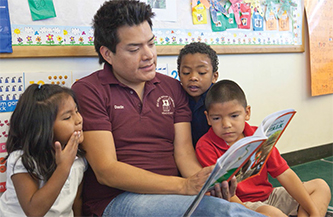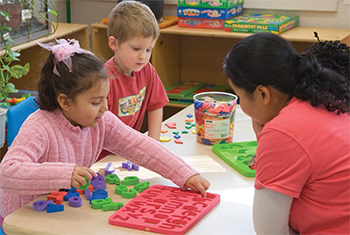Domain: Language and Communication
Sub-Domain: Attending and Understanding
Goal P-LC 1. Child attends to communication and language from others.
| Developmental Progression | Indicators | ||
|---|---|---|---|
| 36 to 48 Months | 48 to 60 Months | By 60 Months | |
| Shows acknowledgment of comments or questions and is able to attend to conversations, either spoken or signed. | Shows acknowledgment of complex comments or questions. Is able to attend to longer, multi-turn conversations, either spoken or signed. |
| |
Goal P-LC 2. Child understands and responds to increasingly complex communication and language from others.
| Developmental Progression | Indicators | ||
|---|---|---|---|
| 36 to 48 Months | 48 to 60 Months | By 60 Months | |
| Understands and responds (verbally and non-verbally) to increasingly longer sentences, simple questions, and simple stories. | Shows an understanding of complex statements, questions, and stories containing multiple phrases and ideas, and responds appropriately. |
| |
Sub-Domain: Communicating and Speaking
Goal P-LC 3. Child varies the amount of information provided to meet the demands of the situation.
| Developmental Progression | Indicators | ||
|---|---|---|---|
| 36 to 48 Months | 48 to 60 Months | By 60 Months | |
| Uses language, spoken or sign, for different purposes and is sometimes able to provide sufficient detail to get needs met from a variety of adults. | Uses language, spoken or sign, for a variety of purposes and can typically provide sufficient detail in order to get needs met from a variety of adults. |
| |
Goal P-LC 4. Child understands, follows, and uses appropriate social and conversational rules.
| Developmental Progression | Indicators | ||
|---|---|---|---|
| 36 to 48 Months | 48 to 60 Months | By 60 Months | |
| Engages in conversations with adults, other children, or within the group setting lasting two or three conversational turns, and, with support, will sometimes use appropriate tone and volume for different situations. | Maintains multi-turn conversations with adults or other children by being responsive to the conversational partner in a variety of ways, such as by asking a question. With increasing independence, varies tone and volume of expression to match the social situation. |
| |
Goal P-LC 5. Child expresses self in increasingly long, detailed, and sophisticated ways.
| Developmental Progression | Indicators | ||
|---|---|---|---|
| 36 to 48 Months | 48 to 60 Months | By 60 Months | |
| Communicates clearly enough to be understood by familiar adults, but may make some pronunciation and grammatical errors. Typically uses three- to five-word phrases/sentences when communicating. With some prompting, can offer multiple (two or three) pieces of information on a single topic. | Communicates clearly enough to be understood by familiar and unfamiliar adults, but may make some pronunciation errors and some isolated grammatical errors. Uses longer sentences, as well as sentences that are slightly more complex, such as "I need a pencil because this one broke." Can offer multiple pieces of information on a topic with increasing independence and answer simple questions. |
| |
 Evidence of attending to others can vary substantially among cultural groups. For example, some children may be taught to observe adults at a distance. Other children may learn to observe up close.
Evidence of attending to others can vary substantially among cultural groups. For example, some children may be taught to observe adults at a distance. Other children may learn to observe up close.Sub-Domain: Vocabulary
Goal P-LC 6. Child understands and uses a wide variety of words for a variety of purposes.
| Developmental Progression | Indicators | ||
|---|---|---|---|
| 36 to 48 Months | 48 to 60 Months | By 60 Months | |
| Shows a rapid increase in acquisition of new vocabulary words that describe actions, emotions, things, or ideas that are meaningful within the everyday environment. Uses new vocabulary words to describe relations among things or ideas. Shows repetition of new words offered by adults. | Shows a steady increase in vocabulary through the acquisition of words with increasing specificity and variety. Shows repetition of new words offered by adults and may ask about the meaning of unfamiliar words. |
| |
Goal P-LC 7. Child shows understanding of word categories and relationships among words.
| Developmental Progression | Indicators | ||
|---|---|---|---|
| 36 to 48 Months | 48 to 60 Months | By 60 Months | |
| Typically uses known words in the correct context and, with support, shows an emerging understanding of how words are related to broader categories, such as sorting things by color. | Demonstrates an increasingly sophisticated understanding of words and word categories with support, such as listing multiple examples of a familiar category or identifying a synonym or antonym. |
| |
 Preschoolers show an awareness of alphabet letters and enjoy naming them. They produce the beginning sound in a spoken word.
Preschoolers show an awareness of alphabet letters and enjoy naming them. They produce the beginning sound in a spoken word.Last Updated: May 21, 2024
